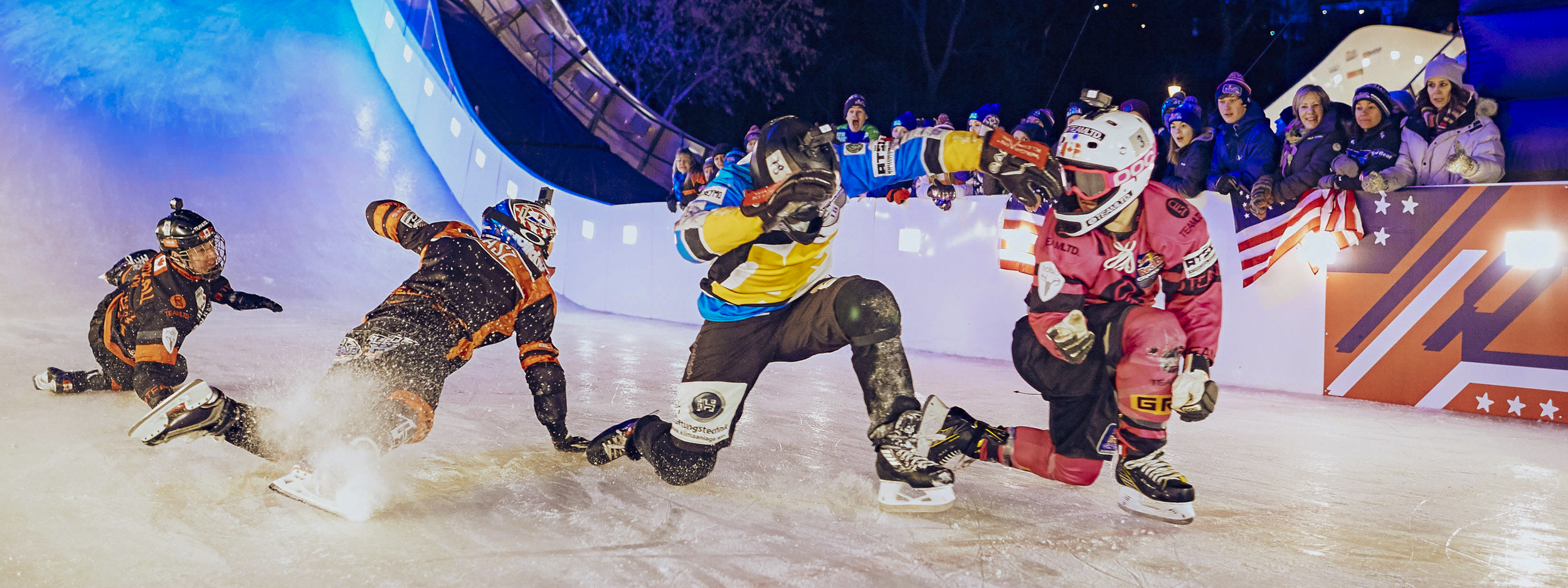Before we talk about Cameron Naasz, downhill skate racer, let’s talk about what he does atop a pair of ice-skates, as it will give some context to the character of this two-time ice racing champion. If you want a visual definition of borderline insanity, watching a Red Bull Crashed Ice event is about the best way to get one. A Crashed Ice race sees heats of four competitors charging downhill one ice-skates at speeds of up to 50 miles per hour. That alone is crazy enough but now add in tight turns, sharp drops, long straightaways, and jumps.
So yes, a downhill ice race on an obstacle course is borderline crazy, but oh boy, is it awesome to watch. And thanks to the skill, fitness, and dedication of the men and women who excel at downhill ice racing, it’s actually not that much more dangerous than any other extreme sport, appearances aside. In fact, if Crashed Ice and other such ice race events continue to gain popularity at their current trajectory, it’s not crazy to think this high-adrenaline sport may one day be mainstream enough for Olympic contention.

That would be a dream come true for Cameron Naasz, reigning two-time Crashed Ice champion, who, at 29 years old, is hoping to secure another win on February -9, 2019 when a Red Bull Crashed Ice race takes place in none other than the home of the Red Sox, Boston’s famed Fenway Park.
Once Naasz had experienced the thrill of downhill ice racing, he was hooked.
How did Naasz reach this potential three-time title? The short answer is that he spent a lot of time on skates. The longer answer is pretty much dumb luck.
“I grew up in Lakeville, Minnesota, so I was always on skates. I first got on the ice at about five years old,” Cameron Naasz explained when we spoke by phone. “Hockey was my major sport, but during the summer I’d put on roller blades. I spent so much time at the skate park, that my mom actually invested in one, so we owned part of the park where I’d skate all the time.”
“But growing up, I had a passion for extreme sports. I was playing hockey, but watching the X Games, those guys were my idols,” he recalled.
By the time Naasz had his first chance to try out extreme skating himself, he had already given up on competitive sports. He was in college and, while still skating for fun and for fitness, had stopped playing hockey and had no plans of making athletic competition a part of his professional future. When a girlfriend sent a link containing info about an upcoming ice race, Naasz planned to attend only as a spectator. At the urging of a few buddies, he instead tried out for the race. Once Naasz had experienced the thrill of downhill ice racing, he was hooked.
And he got into the sport at just the right time, too — a time when extreme ice racing was just starting to go mainstream.
“When Crashed Ice started back in 2009, it was more of a spectacle. It was more like a media deal; just another crazy Red Bull event where people do crazy looking stuff. The biggest progress I’ve seen is that ice [downhill] racing has turned into a sport more than a spectacle. We have national and international associations now. We have governing bodies. There’s a genuine community of racers and a camaraderie between the athletes. We travel all winter together, we practice and train together, we talk about the tracks, about how to go faster here or land that drop there.”

Naasz paused, then added: “Then at the race, of course we all race as hard as we possibly can. Once it’s race night, all that camaraderie is forgotten about. Until the second the race ends, anyway.”
And how does someone train to be a competitive downhill ice racer?
What Cameron Naasz does spend plenty of time thinking about is not only what’s next for him, but for the event at large.
“Since it’s such a unique sport, you have to do unique training,” Naasz explains. “You can’t just train for ice cross — there’s no facility for ice cross training! So I go to hockey specific training centers. I do plyometrics. I go to skate parks and use roller blades, I play hockey to stay in shape and on the ice, I go to a cross fit gym for strength training.”
“And there are sacrifices that come with the sport. Some athletes work seasonal jobs in the summer so they can travel to events. You set aside time for media appearances all year round. And then for three months every winter, I’m traveling the world. It’s great, but it’s a lot.”
When it comes to the possibility of injury, Naasz discussed wearing the proper pads during training and races, how training helps prevent accidents and fitness helps prevent injury, but overall he was circumspect on the topic. “It’s something you try not to think about.”

What Cameron Naasz does spend plenty of time thinking about is not only what’s next for him, but for the event at large.
“I think we could be an Olympic event for sure. If you see ski cross, for example, it’s the same thing. We just need to develop more associations, get a bit more official. The Olympic Committee has been to out events and they’re already contemplating it. We just need to develop a bit more.”
Gaining more fans will help, too. But that process is already well under way.







